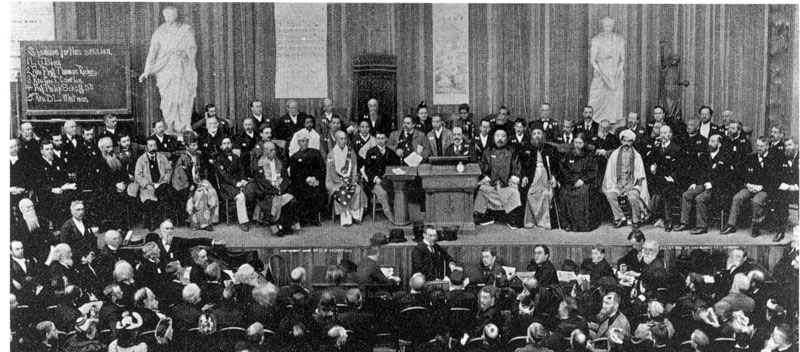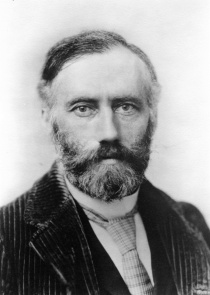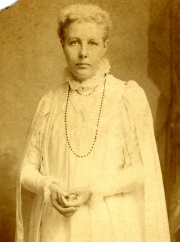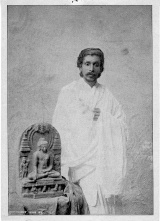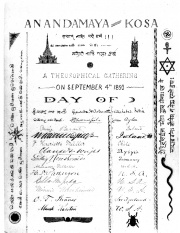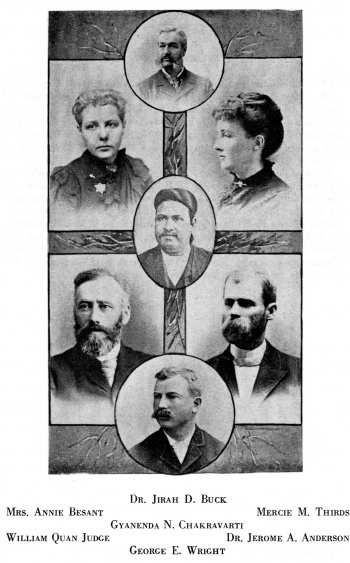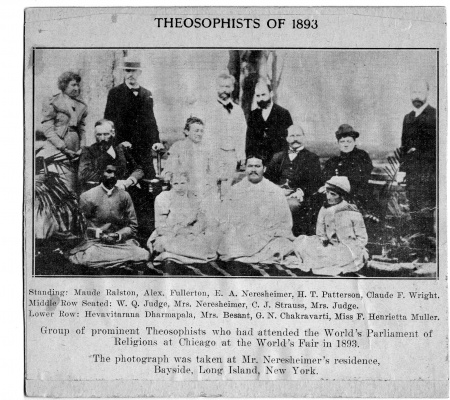World's Parliament of Religions (1893): Difference between revisions
No edit summary |
|||
| Line 154: | Line 154: | ||
[[File:Theosophists of 1893.jpg|450px|thumb|Theosophists assembled after Parliament]] | [[File:Theosophists of 1893.jpg|450px|thumb|Theosophists assembled after Parliament]] | ||
Many members of the Theosophical Society attended the Theosophical Congress. [[August Neresheimer|E. A. Neresheimer]] of the [[Aryan Theosophical Society]] and his wife Minnie hosted the Society's delegation as they assembled in New York after Chicago. Maude Ralston, [[Alexander Fullerton]], [[Henrietta Müller|Miss F. Henrietta Müller]], [[C. | Many members of the Theosophical Society attended the Theosophical Congress. [[August Neresheimer|E. A. Neresheimer]] of the [[Aryan Theosophical Society]] and his wife Minnie hosted the Society's delegation as they assembled in New York after Chicago. Maude Ralston, [[Alexander Fullerton]], [[Henrietta Müller|Miss F. Henrietta Müller]], [[C. T. Strauss]], and Mrs. Ella Judge were listed among the party. | ||
[[George E. Wright]] headed the host committee in Chicago. | [[George E. Wright]] headed the host committee in Chicago. | ||
Latest revision as of 20:26, 20 November 2024
The World's Parliament of Religions was an event held September 11-27, 1893, in Chicago, in conjunction with the World's Columbian Exposition. It heralded the birth of a worldwide interfaith dialogue that has continued with the Parliaments of the World's Religions in 1993 (Chicago), 1999 (Cape Town), 2004 (Barcelona), 2009 (Melbourne), 2015 (Salt Lake City), 2018 (Toronto), and 2023 (Chicago).
A Theosophical Congress was held within the greater Parliament on September 15-17, and it featured some of the Theosophical Society's best lecturers.
Theosophical Delegates to the Parliament
Theosophists around the world regarded the Parliament and its Theosophical Congress as a huge event, supporting its Objects regarding universal brotherhood and the study of comparative religions. Planning began well in advance, with an international Advisory Committee of some 190 members.[1]
Henry Steel Olcott, President of the Theosophical Society, wrote about the Society's delegation:
As the World’s Parliament of Religions was to meet at Chicago in the following September, and as it had been arranged that our Society should participate in it, I deputed the Vice-President, Mr. Judge, to represent me officially, and appointed Mrs. Besant special delegate to speak there on behalf of the whole Society. [2]
The official delegation of the Society to the Parliament included Theosophical Society Vice-President William Quan Judge; English orator Annie Besant; Professor G. N. Chakravarti representing Hinduism; the Anagarika Dharmapala representing Buddhism; Miss F. Henrietta Müller representing European Theosophists; and Mrs. Isabel Cooper-Oakley, representing Australia and New Zealand.
Noteworthy speakers at the Parliament
Orientalist Max Müller submitted a paper to be read at the Parliament, but did not attend in person.[3]
Indian Professor Manilal N. Dvivedi, was not a member of the TS delegation, although he was a member of the Advisory Committee for the Theosophical Congress. An eminent Sanskrit scholar, he was invited to represent the viewpoint of Hinduism at the Parliament, but did not speak at the Theosophical Congress. His translations and commentaries were frequently published in Theosophical journals.
Another representative of Hinduism was Swami Vivekananda, who brought the audience of 7000 people to its feet with an electrifying speech that began "Sisters and brothers of America!"
Theosophical Congress at the Parliament
A Theosophical Congress was held within the greater Parliament of September 15-16. Quite an effort was necessary to arrange for this event.
Mr. Judge had written privately to Mr. George E. Wright, a leading member of the Chicago Branch, suggesting that an effort be made to secure representation for the T.S. at the World's Parliament of Religions to be held at the Chicago Fair in 1893. This was in the Fall of 1892. Mr. Wright set to work and after some difficulty the necessary recognition was achieved and dates arranged for the Theosophists. The idea of Theosophical representation was received with acclaim in Europe and India as well as among the American members. When Mr. Bertram Keightley arrived in America Mr. Judge at once broached to him the advisability of Brahminical as well as Buddhistic representation at the Parliament and, without disclosing more than the apparent advantages, suggested that such representation should be under the auspices of the T.S., and requested Mr. Keightley's advice and aid in procuring representation the most distinguished possible. Mr. Bertram Keightley urged the selection of G. N. Chakravarti as representing the Brahmins and H. Dharmapala, a distinguished Ceylonese, for the Buddhists. He undertook to secure the consent of Chakravarti. Accordingly, subscriptions were opened in the United States and in England to defray the traveling expenses of the two delegates.[4]
During the months before the event, participation by Theosophists in the Parliament was in doubt due to obstruction by the organizers. Mr. Judge wrote:
The Congress of the Theosophical Society in September [1893] as a part of the Great Parliament of Religions was a significant as well as successful event...
We had little hope at first of having any place in either the intellectual or the religious side of the World's Fair; we found the old yet senseless opposition to Theosophy obstructing the path. Suddenly the scene changed and the managers of the Parliament of Religions became our friends and helpers. This change will never be explained by those who do not know the forces working behind the acts and thoughts of men. It not only took us into the parliament, but gave us the best date of all sittings and made our Congress the real Parliament itself...
It was distinctly a Theosophical step because, being an effort to get on one platform representatives of all religions, it was just what our Society has been accomplishing steadily and what our objects and constitution has always expressed. [5]
All six of the credentialed Theosophical Society delegates to the Parliament spoke at the Congress, along with Dr. Jerome A. Anderson, Claude Falls Wright, Mrs. Mercie M. Thirds, Dr. J. D. Buck, and George E. Wright.
Program of the Theosophical Congress
According to the Supplement to The Theosophist in September, 1893, the Theosophical Congress offered a very comprehensive and ambitious program of lectures:
The following programme will be carried out on September 15th and 16th next, the two days set aside for Theosophy at the Parliament of Religions at Chicago: -
I. THEOSOPHY DEFINED.
- 1. The theosophical Doctrine of the Unity of all Spiritual Beings.
- 2. The Eternal Unity of Spirit and Matter.
- 3. Theosophy is a System of Truths, discoverable and verifiable by perfected men.
- 4. These Truths are preserved in their purity by the Great Brotherhood of Initiates, the Masters of Wisdom, who promulgate them more and more fully as the evolution of man permits.
II. THEOSOPHY HISTORICALLY CONSIDERED, AS THE UNDERLYING TRUTH OF ALL THE WORLD'S SCRIPTURES, RELIGIONS AND PHILOSOPHIES.
- 1. As found in the Sacred Books of the East and of Egypt.
- 2. As found in the Hebrew Books, and in the New Testament of the Christians.
- 3. As found in Greek and Gnositic Philosophy.
- 4. As found in European Mediaeval Philosophy.
- 5. As found in European Mysticism.
- 6. Esotericism in Religions.
- 7. Links between Religion and Science.
- 8. Revelation not a special property of any one religion.
- 9. The Secret Doctrine and its Guardians.
III. THE PHILOSOPHY AND PSYCHOLOGY OF THEOSOPHY.
- 1. The Cosmos Septenary in its Constitution.
- 2. Man, the Mirror of the Cosmos and Thinker.
- 3. The Inner and the Outer Man.
- 4. States of Consciousness.
- 5. Evolution of the Soul.
- 6. Karma, the Law of Causation, of Justice and Adjustment of Effects.
- 7. Reincarnation of the Soul a Law of Nature.
- 8. The Doctrine of Universal Brotherhood as a fact in Nature.
- 9. The Theosophical View of Death.
- 10. Man, a Sevenfold-Being, thus corresponding to the Cosmos.
IV. THE THEOSOPHICAL MOVEMENT IN ITS ORGANIZED LIFE.
- 1. The Objects of the Theosophical Society.
- 2. Its Relation to Civic Affairs and Education.
- 3. The Mission of the Theosophical Society.
- 4. The Constituted Methods of Administration and Work, the conduct of Branches and their Autonomy; Propaganda.
- 5. The Society absolutely Unsectarian, without a creed, and open to persons of all faiths. Acceptance of doctrines largely taught in Theosophical Literature not incumbent; Universal Brotherhood the only theory required to be embraced.
V. THEOSOPHY AND MODERN SOCIAL PROBLEMS.
- 1. Its insistence on Justice and Unselfishness as the basis of Community Life.
- 2. Its doctrine of Evolutionary Reincarnation as applied to the Sexes.
- 3. Its claim that social evils have their roots in mental faults, and that in addition to legislative, educational, and social improvements, the truths and laws of being must be taught for the fundamental regeneration of society, and the recognitition of Karma and Reincarnation must be made the basis of concerted public, as well as of private, efforts.
VI. THEOSOPHY AND SCIENCE.
- 1. Theosophy hostile to science only when Materialistic, when it repudiates all spheres and processes other than physical, or denies the reality of soul and spirit and the unseen universe.
- 2. Theosophy, as a Universal Philosophy, appropriates all spheres of being and claims a scientific investigation of each.
- 3. The sanction of Right Ethics found in Universal Brotherhood as a fact and not merely a sentiment; enforcement of right ethics found in the power which the knowledge of karma and Reincarnation has on the individual.
- 4. Theosophy offers no new system of right ethics, since right ethics do not vary but are always the same as taught by all great religious teachers.[6]
Financial support for the Congress
Members of the Theosophical Society donated to a Theosophical Congress Fund to cover the expenses of the event. American Theosophists donated about $1300 and Europeans donated about $765. An accounting of income and disbursements was published each month by William Quan Judge in the American Theosophical journal The Path. Expenditures included travel from India and other countries, and the costs of printing the Report of Proceedings and Documents. A final surplus was distributed among the American, European, and Indian Sections.[7]
Report of Proceedings and Documents
A complete Report of Proceedings and Documents of the Theosophical Congress was issued by the publishers of The Path late in 1893, facilitated by donations:
Contributions towards the expenses of the Congress have been so generous that a surplus exists, and there has been decision to use this in printing a verbatim report of the proceedings and addresses as a permanent record of so important an event. The speeches were taken down by stenographers and are being rapidly set up in type. It is expected that he Report, which will make a book of 175 pages, will be issued soon after the appearance of November PATH. Each subscriber to the fund will receive one by mail, and copies will be on sale at 30 cents each, paper; 75 each, cloth, postpaid in either case. Orders can be sent now to the PATH and will be filled in due course."[8]
Accounts of the Parliament and Congress
From Colonel Olcott
Theosophical Society president Col. Henry Steel Olcott could not attend the Parliament, but keenly followed the event and wrote of it in his diary:
How great a success it was for us and how powerfully it stimulated public interest in our views will be recollected by all our older members. Theosophy was presented most thoroughly both before the whole Parliament, an audience of 3,000 people, and at meetings of our own for the holding of which special halls were kindly given us. A profound impression was created by the discourses of Professor G. N. Chakravarti and Mrs. Besant, who is said to have risen to unusual heights of eloquence, so exhilarating were the influences of the gathering. Besides these who represented our Society especially, Messrs. Vivekananda, V. R. Gandhi, Dharmapala, representatives of the Hindu Vedanta, Jainism, and Buddhism respectively, captivated the public, who had only heard of the Indian people through the malicious reports of interested missionaries, and were now astounded to see before them and hear men who represented the ideal of spirituality and human perfectibility as taught in their respective sacred writings.[9]
From William Quan Judge
William Quan Judge as Vice President of the Theosophical Society and head of the TS delegation, wrote of the Parliament in The Path:
Not at any time but now during eighteen centuries could such a meeting have been possible, and it was distinctly a Theosophical step because, being an effort to get on one platform representatives of all religions, it was just what our Society has been accomplishing steadily during the past eighteen years, and what our objects and constitution have always expressed...
All our meetings were crowded to overflowing, every shade of opinion was on our platform as well as in our audiences, and, recognizing the effect produced by such an epoch-making Congress as ours, the newspapers of the city, which only attend to that which forces itself to the surface, gave us in their reports the greatest prominence, saying one day, "The Theosophical Congress is a competitor of the whole Parliament."[10]
From Annie Besant
Colonel Olcott reported Mrs. Besant's comments to a London newspaper:
The Theosophical Congress, as said one of the leading Chicago papers, was a rival of the Parliament itself in the interest it excited. The plan of the Department of Religion was a good one. Each body strong enough to hold one, had a congress of its own on one or more days, fixed by the committee; in addition to this, chosen speakers occupied one session in presenting the views of their body to the Parliament. The Theosophical Society was given two days for its congress, the evening of the second day being devoted to the presentation of Theosophy before the Parliament. The hall originally granted to it seated about 300 people, but it was so densely packed before the first meeting opened, that the managers gave us another hall seating about 1,200. This was promptly filled, and at each succeeding session the crowds grew, filling passages and packing every inch of room, until at our fifth session two adjoining halls were offered us, and we held two overflow meetings in addition to our regular session. The sixth session was the presentation of Theosophy to the Parliament, and some 3,000 people gathered in a huge hall. So intense was the interest shown that the management most generously offered us the use of the great hall for an additional meeting on the following night, and it was packed with eager listeners. In addition to the Indian and Sinhalese delegates above named, the Theosophical Society sent from its European Section Annie Besant, Miss F. H. Müller, and Mrs. Cooper-Oakley; the American Section was represented by its General Secretary, Wm. Q. Judge, Dr. Jerome Anderson of San Francisco, Mr. George E. Wright and Mrs. Thirds, of Chicago, and Claude F. Wright of New York; the Australasian Branches delegated Mrs. Cooper-Oakley, who had been working among them for ten months, and who came direct from Australia to Chicago. Between the interest excited by the speakers and the far deeper interest excited by the subjects dealt with, the meetings were rendered thus successful.[11]
Impact of the Parliament
Through the Parliament, Theosophists became acquainted with scholars and religious leaders who were influential directly or indirectly to the Theosophical Movement; some of those scholars were in turn influenced by the principles of Theosophy.
Soyen Shaku, Toki Horyu, and others formed a delegation of Zen Buddhists from Japan. Soyen Shaku met Dr. Paul Carus at the Parliament, and that directly led to the long association of the Open Court Publishing Company editor with D. T. Suzuki.[12] The Japanese delegation returned home through Europe. While in London, they visited the headquarters of the Theosophical Society in England, and signed the guest book on October 19th.[13][14] Soyen Shaku described the Parliament as "the forerunner of the future universal religion of science."[15]
Theosophists attending the Parliament
Many members of the Theosophical Society attended the Theosophical Congress. E. A. Neresheimer of the Aryan Theosophical Society and his wife Minnie hosted the Society's delegation as they assembled in New York after Chicago. Maude Ralston, Alexander Fullerton, Miss F. Henrietta Müller, C. T. Strauss, and Mrs. Ella Judge were listed among the party.
George E. Wright headed the host committee in Chicago.
Members of the Cincinnati Theosophical Society had an excursion to Chicago on September 15-17, traveling on the Cincinnati, Hamilton and Dayton Railroad at a cost of $7.00 per person. The lodge had a foretaste of the Theosophical Congress on Saturday, September 9, when William Quan Judge, Annie Besant, and Professor Chakravarti made a stop in Cincinnati on their way to Chicago and lectured at the dedication of the new Theosophical Hall. Of the Parliament, Dr. Buck briefly recounted that:
All of the meetings were largely attended and that the platform of the World's Congress of Religions was exactly that of the Theosophical Society in that the latter had for its object the establishment of a nucleus for the Universal Brotherhood of Man and desired to demonstrate the one common basis of all religions."[16]
Dr. Herbert Coryn, a personal student of Theosophical Society Founder Helena Petrovna Blavatsky, and president of the Brixton Lodge, came from England to attend the Theosophical Congress. He served on on Judge's Advisory Council.[17]
Frederick J. Kunz and his large family from Freeport, Illinois were in attendance, except for the youngest son, Fritz Kunz, who was only five years old. Afterward, the entire household joined the Theosophical Society and became the mainstay of the Freeport Lodge. Fritz often spoke of his disappointment at missing the trip to Chicago.[18]
Several Theosophists are known to have been in Chicago in 1893 to attend the World's Columbian Exposition, and may have also attended in the Theosophical Parliament. L. Frank Baum and mother-in-law, feminist Matilda Joslyn Gage, fall into this group. Similarly, Bertha E. Jaques was present in 1893, and took up her artistic career after seeing an exhibit of etchings.[19] The family of Marc Edmund Jones, who was five years old like Fritz Kunz, was living in Chicago, and took him to the World's Columbian Exposition. William H. Terry travelled from Australia.[20]
Additional resources
Books
- Barrows, John Henry. The World's Parliament of Religions, An Illustrated and Popular Story of the World's First Parliament of Religions. Two volumes. Chicago: The Parliament Publishing Company, 1893. A very detailed contemporary account of the Parliament, including the text of many major addresses such as that of Willaim Quan Judge.
- Seager, Richard. Dawn of Religious Pluralism: Voices From the World's Parliament of Religions, 1893. Open Court Publshing, 1999.
- Seager, Richard. The World’s Parliament of Religions: The East/West Encounter, Chicago, 1893. Bloomington, IN: Indiana University Press, 2009. Religion in North America series.
Archival collections
- Jenkin Lloyd Jones World’s Columbian Exposition at Illinois Digital Archives. Digital copies of correspondent and scrapbooks are available.
Proceedings of the Congress
The complete Report of Proceedings and Documents of the Theosophical Congress is available at Internet Archive, Hathitrust, and Google Books.
Articles about the Parliament
- World Parliament of Religions in Theosophy World
- Parliament of Religions in Theosophy World
Addresses delivered at the Parliament
- Braybrooke, Marcus. "Pan-Asian Participation in the 1893 Parliament" in The Interfaith Observer website. Posted November 15, 2012. Accessed March 25, 2020.
- Judge, William Quan. Organized Life of the TS.
- Judge, William Quan. Theosophical Doctrine.
- Judge, William Quan. Theosophy Generally Stated.
- Judge, William Quan. Universal Brotherhood a Fact in Nature. ‘’Theosophy’’ 50.12 (October, 1961), 537-542. Reprinted from the Report of Proceedings issued by the American Section of the Theosophical Society. Also reprinted in ‘’Theosophy’’ in 1947.
Video
Notes
- ↑ Report of Proceedings and Documents (New York: American Section Headquarters T.S., 1893), 10-12.
- ↑ Henry S. Olcott. Old Diary Leaves, Fifth Series (1893-1896) (Adyar, Madras, India: Theosophical Publishing House) 35. Available at Theosophical Society in The Philippines.
- ↑ Lysy, 13.
- ↑ John Garrigues and others, The Theosophical Movement 1875-1925: A History and a Survey, 446. See Blavatsky Archives website.
- ↑ William Quan Judge. Echoes of the Orient: the Writings of William Quan Judge Vol II. Second edition. Edited by Dara Eklund. (Pasadena, CA: Theosophical University Press, 2009), 168-169. Available online at [http://www.theosociety.org/pasadena/wqj-echoes/EchoesOrient2-WQJ.pdf Theosophical University Press Online.
- ↑ "Theosophy in the Parliament of Religions," Supplement to The Theosophist 14:12 (September, 1893), lxxxix-xc. Available online at Theosopher.net.
- ↑ William Quan Judge "Theosophical Congress Fund" The Path 8.11 (February, 1894), 368.
- ↑ Anonymous. "Report of Theosophical Congress at World's Fair, Chicago" The Path 8.8 (November, 1893), 259.
- ↑ Henry S. Olcott. Old Diary Leaves, Fifth Series (1893-1896) (Adyar, Madras, India: Theosophical Publishing House) 35. Available at Theosophical Society in The Philippines.
- ↑ William Quan Judge, "The Theosophical Congress and the Parliament of Religions" The Path VIII (November 1893), 247-249. Quoted in Echoes of the Orient Volume II, pages 159-160.
- ↑ Henry S. Olcott. Old Diary Leaves, Fifth Series (1893-1896) (Adyar, Madras, India: Theosophical Publishing House) 36-37. Available at Theosophical Society in The Philippines.
- ↑ Rick Fields, How the Swans Came to the Lake: A Narrative History of Buddhism in America (Boulder, Co: Shambhala Publications, 1992), 128.
- ↑ "Toki Horyu (Biographical details)" in British Museum website. Accessed August 7, 2017.
- ↑ Leslie Price email to Janet Lee. July 18, 2017. Copy at Theosophical Society in America Archives.
- ↑ Anton Lysy, "Parliament of Religions 1893/1993: Advocates of the Great Orphan, Humanity" The Quest 5.3 (Autumn, 1992), 12.
- ↑ Minute Book of the Cincinnati Theosophical Society. September 5-19, 1893. Cincinnati Theosophical Society Records. Records Series 20.02.01. Theosophical Society in America Archives.
- ↑ The Theosophical Congress held by the Theosophical Society at the Parliament, World's Fair of 1893, at Chicago, Ill., September 15, 16, 17. New York: American Section Headquarters T.S., 1893. pg 10.
- ↑ Kunz Family Collection. Records Series 25.01. Theosophical Society in America Archives.
- ↑ "Mrs. Bertha E. Jaques" at Smithsonian American Art Museum website.
- ↑ "A Farewell Reception" The Cleveland Leader (November 1, 1893), 5.
